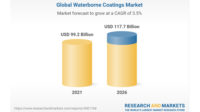Report Claims Market for Hydrophobic Materials and Surfaces Will Reach $1.8 Billion

GLEN ALLEN, VA - Industry analyst firm n-tech Research has released a new report titled Hydrophobic Coatings and Surfaces: 2016 to 2023. According to the report, the market for hydrophobic materials used for self-cleaning, de-icing, anti-fouling and anti-corrosion applications will grow to $1.8 billion by 2021.
Until recently, hydrophobic coatings have been regarded as semi-commodities. However, novel hydrophobic materials based on carbon nanotubes, graphene, nanoparticulate calcium carbonate and various nanocomposites have expanded the opportunities for hydrophobics and are expected to create a new breed of superhydrophobic products.
The report also covers the latest developments from more conventional silicon-based hydrophobic materials as well as novel patterning approaches for creating hydrophobic surfaces. In addition, the report includes detailed eight-year forecasts of volume and revenue, broken down by material type and application/end-user sector.
The report identifies opportunities for hydrophobic functionality in automotive, aerospace, marine, construction, solar, wind generators, textiles, consumer electronics, food processing, medical and water treatment. The focus of the analysis is on self-cleaning, anti-corrosion, anti-fouling and de-icing, but it also examines commercial applications for oleophobic and omniphobic applications.
Researchers at n-tech believe that if cost challenges can be overcome, hydrophobic materials based on carbon nanotubes (CNTs) will lead to a new generation of high-performance superhydrophobic materials. Promising designs for these novel CNT-based hydrophobes include those utilizing CNT “forests,” CNT meshes and approaches making use of the intrinsic hydrophobic channels in CNTs themselves. By 2021, sales of CNT-based hydrophobic coatings are expected to reach more than $360 million.
Low-performance, semi-commoditized hydrophobic materials have been used on building surfaces for years. However, the most innovative self-cleaning building products – windows, tiles and wall panels – have tended to use hydrophilic technology. The new superhydrophobic technologies will catch up with hydrophilic products, and by 2021, the construction industry will account for more than $724 million in hydrophobic coatings and surfaces.
The report predicts that by 2021, the automotive sector will spend $305 million on hydrophobic materials and surfaces. These will be especially useful for cleaning and anti-stain functionality in buses and taxis, which have to cope with large numbers of passengers. However, for private vehicles, hydrophobic coatings will be positioned as “what’s next” after conventional polishes and coatings. Nissan has already developed a “concept car” with a superhydrophobic coating.
Details about the report can be found at http://ntechresearch.com/market_reports/hydrophobic-coatings-and-surfaces-2016-2023.
Looking for a reprint of this article?
From high-res PDFs to custom plaques, order your copy today!







